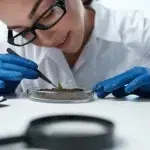In the 1850s, a British couple moved to New South Wales, Australia, where they eventually purchased a small orchard. Maria and Thomas Smith had worked as farm laborers/orchardists in England (in fact that’s how they met…on the farm), so they were well versed in fruit cultivation. Maria became locally well known for baking fruit pies, which led a local wholesaler to give her a box of French crab apples from Tasmania. She made some pies, and then threw the apple peels and cores in her compost heap close to the creek on her property.
Not too long afterwards, she noticed a pippin had sprouted in her compost heap. Normally, she would have pulled the sprout out of the ground, but she let it grow and even tended it as though it were growing in the orchard and not some compost heap.
By 1868, the small pippin had become a tree bearing a previously unknown variety of tart, firm apples perfect for pies. Unfortunately, Maria passed away two years later. Fortunately for the rest of the world, Maria’s reputation for baking lived on—and people realized no matter how talented a baker, Maria’s special apples played a role in the tastiness of her pies. A local orchardist took cuttings from Maria’s tree and named the fruit variety after the woman who made it locally popular. Thus, the Granny Smith apple started its commercial journey.
Today, the U.S. Apple Association lists Granny Smith as the third most popular variety in America. The Granny Smith apple we eat today tastes the same as it did when Granny Smith herself baked pies from the fruit growing on her compost-heap tree. These apples taste the same as the fruits grown more than a century ago for one primary reason: All are grown from genetic clones of the original tree.
Cannabis, apples, wine, and genetics
What do cannabis and apples have in common? Well, they’re both higher plants. Beyond that, they’re both angiosperms. But what else? Both cannabis and apples are primarily vegetatively propagated for commercial purposes. In other words, cuttings are taken from both apple trees and cannabis plants to make genetic clones that are used for growing the next generation of plants. The key is all are clones of their mother plant. Granny Smith’s apples taste the same a century later because today’s apples and the originals are genetically identical.
The same thing happens with cannabis. You can go into a dispensary and purchase some OG Kush, and as long as that cannabis flower is derived from the same genetics, you will get a relatively similar experience each time you purchase OG Kush. Having said that, a lot of variables affect cannabis floral quality regardless of genetics. This is similar to wine production. A 1997 Chateau Montelena Cabernet Sauvignon is going to be different from a 2018 Beringer Cabernet Sauvignon. Whether one wine is better than the other is subjective, but a lot of variables affect the flavor, aroma, and overall experience, which is why vineyards use genetically identical clones. As a cannabis cultivator, I am very interested in producing the same or similar product time and time again. Growing from vegetative clones is the strongest arrow in my quiver to help accomplish crop uniformity.
What about clones of clones?
Remember the 1996 romantic comedy Multiplicity starring Michael Keaton? In the movie, Doug (Keaton) discovers he can clone himself so he can meet the demands of his busy schedule. Unfortunately, things take a hilarious turn for the worse when Doug’s clone clones himself. Doug’s clone’s clones are not exactly up to the same quality as Doug or even his clone. They start wreaking havoc as the clone’s clones can’t function normally in Doug’s world. They explain this by saying a copy of a copy is not as high-quality as a copy of the original.
As a whole-plant physiologist, I can assure you what happened in Multiplicity does not happen in the plant world. Taking clones from clones that came from clones of the clones originally taken from the clones of the original mother plant works perfectly well in the plant world. Plants don’t work like typical animals when it comes to an ability to reproduce. Plants are modular organisms that rely on something called totipotency to help them with vegetative propagation. Totipotency means any cell in a plant that is living can de-differentiate and re-differentiate into any other type of plant tissue. This makes sense in nature. What happens if an herbivore chews a tree down to its stump? The tree can’t get up and run away to avoid herbivory; it must find another way to survive. It behooves the stump to change some of its tissue to differentiate into stem and leaf tissues that have been chewed away. This is all managed internally at the cellular level using internal hormone balances, but that’s a different, more complicated discussion. Let’s just take away from this discussion that plants can create roots or shoots from any living cell.
Plants have evolved to deal with the fact they are sessile organisms by becoming easy to propagate vegetatively. Some plants are better at this than others; for example, there’s a plant whose common name is “Mother of Thousands,” which is so named because it vegetatively propagates itself by creating plantlets on the margins of its leaves. The plantlets easily fall off and can grow to be independent genetic clones of the original mother plant. If you’ve ever grown a Mother of Thousands plant or have seen them, you understand they are very, very good at vegetative propagation. Mother of Thousands clones go on to make genetic clones themselves. The clones of clones are not qualitatively different from the “original” Mother of Thousands. They are identical. Luckily, we cultivators can use this unique quality of all plants to our advantage by creating clones ourselves.
Tired genetics?
One of the great pleasures I’ve had as a nerd working in the cannabis industry is being welcomed onto people’s farms to help them with their grows. On more than one occasion, I have come across farmers who said they had to retire the mother genetics because the genetics got “tired.” Of course, I had to ask what they meant by genetics getting tired. Generally speaking, there was never a satisfactory response. Plant genetics don’t really get “tired.” So, why do we hear over and over again that cannabis moms’ genetics get tired over time? “Tiredness” is not so much a function of genetics; instead, it usually indicates the mom is outgrowing her environment. The mom likely is rootbound, which diminishes her productivity. Additionally, as plants become woodier they become less likely to spawn viable cuttings, because tissues are less likely to de-differentiate successfully into stem cells. There is also a possibility of a shift in epigenetics. A discussion of epigenetics could be the subject of another Ph.D. dissertation (which I am uninclined to pursue) but suffice to say a change in epigenetics can shift the expression of genetics. Having said that, a change in epigenetics does not equal a change in genetics. The plants remain genetically identical but may show different expressions. This has not been shown to be the case in cannabis, although it is a possibility.
Bottom line: Neither mother plants nor genetics get tired. A drop in cutting viability very likely is caused by rootbound mother plants or cuttings taken from woodier parts of the mom.
Clones vs. seeds
Whether a farmer propagates cannabis via clones or seeds depends on what the farmer seeks; neither propagation method is inherently better than the other. To produce a uniform crop, genetic clones are the way to go. To propagate a lot of plants (as in field-grown hemp), seed propagation is the way to go. Cannabis tends to be a rather heterozygous crop, so seed production will introduce a good amount of variability, which is why clonal production from moms or tissue culture is so widely used for large-scale cannabis cultivation.
There’s a reason even Granny Smith practiced clonal propagation: It has worked for as long as mankind has cultivated plants.
 Dr. Roberty Flannery is the first Ph.D. in the United States with technical training and expertise in commercial cannabis cultivation. His doctoral work at University of California, Davis, focused on plant biology with an emphasis in environmental horticulture and specific study in hydroponic crop optimization. Flannery is chief executive officer for Dr. Robb Farms, which cultivates cannabis and produces infused products throughout California.
Dr. Roberty Flannery is the first Ph.D. in the United States with technical training and expertise in commercial cannabis cultivation. His doctoral work at University of California, Davis, focused on plant biology with an emphasis in environmental horticulture and specific study in hydroponic crop optimization. Flannery is chief executive officer for Dr. Robb Farms, which cultivates cannabis and produces infused products throughout California.










